Beautiful boules with a banneton (brotform)
Keep that scorchy flour off your lens!
People have asked how to prevent free-form loaves from spreading sideways, especially if the dough is a little too wet or it’s near the end of its batch-life (two weeks). Using a banneton (or in German, brotform), is one gorgeous solution to the problem, and they work well with our method. But, you’ll have to make a few adjustments. Interested? Bannetons (brotforms) are wicker rising baskets available from baking supply places or on Amazon. By containing the rising/resting dough, the basket prevents sideways spread with wet dough, and creates a beautiful pattern of flour that contrasts nicely with slash-marks. Since very small bannetons (5 or 6 inches would be ideal) are hard to find, you’re stuck making large loaves, like the one in the picture, with my 8 to 9-inch banneton. That’s OK, but keep in mind that rising/resting times, and most importantly, baking time, will have to increase dramatically. To make the loaf in the pictures took nearly 3 pounds of Italian Peasant dough (page 46 in the book). So, here’s how to use the banneton:
Put some white flour into the bottom of the banneton and then shake it all around so it coats the sides. Be generous with the flour!
Shape and “cloak” a round freeform loaf as usual, pinching together the loose ends underneath. Choose a loaf-size so the dough comes about 2/3’s of the way up the sides of the banneton. Place the loaf into the banneton with the irregular side up. The smooth cloaked side should be in contact with the wicker basket. For the 8 to 9-inch banneton, this took about 3 pounds of dough, so the loaf needed along rest to come close to the top of the basket, about 2 hours. Twenty to forty minutes before baking, preheat your oven to 450 degrees F, with a baking stone near the center of the oven and a broiler tray on any other shelf that won’t interfere with rising bread:
After the dough is rested, use your fingers to be sure that it isn’t sticking to the wicker (it wasn’t). Don’t dig way down or you’ll start deflating everything. Gently turn the basket over onto your preheated stone; it should gently drop onto the stone. If it doesn’t, help it out with your fingers and make the best of it. It should be salvageable even if it deflates a bit, because of oven spring. Slash the loaf in a cross, which will be beautiful with the concentric circles of flour:
Now comes the tricky part; this is a beastly huge bread. It took about an hour in my oven at 450 and I was happy with the result (crumb pictured below, crust above). When you make a large loaf you risk doughiness in the center; let the crust get deep, deep brown. Frankly, mine could have gone even longer. It’s tough to overbake large loaves made from high-moisture dough. But the result was worth the effort. If I can find a small banneton, I’ll post again.
Note: BreadIn5.com is reader supported–when you buy through links on the site, BreadIn5 LLC earns commissions.
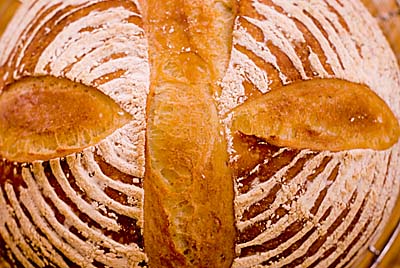

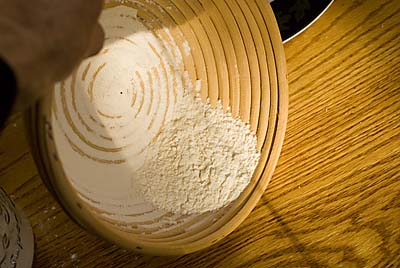
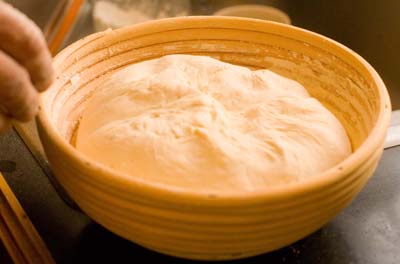
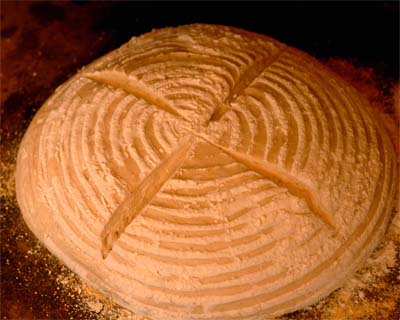
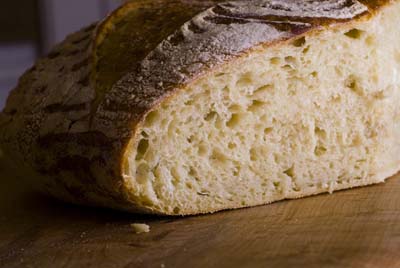
In German a banneton is also called G
Lovely! I’ll have to try this. What I have been doing to keep the dough from spreading out too much is to let it rise on a parchment paper lined cookie sheet with an inverted tupperware bowl over it. Keeps it warm for the rise and keeps the dough from spreading too far sideways.
A question (that has nothing to do with this post, sorry!):
I’ve been playing with keeping back a hunk of the dough and using it in my next batch. That has helped the bread develop a lovely, almost sour dough flavor. So have I recreated a quasi-sourdough starter? And can I just keep using the previous dough as my ‘starter’ without adding new yeast?
LJ: Everyone’s coming up with strategies and they all work.
Another poster told me that they’re using the leftover dough as the only leavening agent and I told them I’d try it, so ditto! Very interesting. You have indeed created a quasi-sourdough starter based on commercial yeast. Over time, however, it will be replaced by wild yeasts and we’ll see if that’s storable. When I experimented with wild yeasts before the book came out, I found that it was a bit unreliable for storage (or at least too temperamental for beginners). So we left it out of the book. Your idea is different since it starts with commercial, not wild yeast.
Jeff
Hello,
I just received the book today and I was skimming through all of the master doughs. I noticed that most of the recipes in the beginning to mid book used 1-1/2 tablespoons kosher salt, whereas several later recipes (especially the enriched doughs) only called for 1-1/2 tablespoon salt (not specifically calling for kosher salt). Because the amount of flour looks to be about the same in these enriched doughs, I am wondering if these enriched dough recipe meant to say “kosher” salt. I checked in your “Errors” section and there wasn’t a mention of this for the enriched dough recipes (although I think it does correct this error for the peasant dough recipe). Anyways, I just wanted to be sure that I have the salt amount clear in my mind.
Thanks,
Dan
Dan: Our mistake, it should say “Kosher” salt throughout. We tested with Moreton’s Kosher salt, just as an FYI. You’ll probably end up altering to fit your taste in any case.
Jeff
Zoe: You say for a one pound loaf you want a 6″ brotform but I could not find one after much searching.
Freiling info states:
Frieling 300x – Round Brotform Bread Rising Baskets
If you are looking to make homemade bread that has a crunchy crust, ribbed, floury d
Jeff,
Thank you for your prompt reply. That was what I thought, I just wanted to be sure. As you know, the level of saltiness can vary considerably if I end up using the wrong type of salt. I’ll just make a note of this in the book.
Dan
Biff:
Thanks for the info on the smaller bannetons/brotforms, this is the first I’ve seen of a 7-incher. I mentioned 6-inches but you’re confirming that it probably doesn’t exist. Our loaves tend to be easier to deal with in smaller versions, so I was hoping for a 6, but 7 is probably fine (I did the one you see in an 8 to 9-inch one). Price is never great, they’re imports and probably handmade. Do you have a website for these?
Jeff
The San Francisco Baking Institute sells bannetons, both round and oval, to accomodate 1 and 1.5 pounds of dough. They are very reasonable, but they also sell some plastic forms that are a even less expensive.
https://www.sfbi.com/baking_supplies.html
Thanks Barbara, this is a great link. I’m a tiny bit skeptical about one thing though. They’re billing the 8-inch banneton as good for 1 to 1.5 lbs loaves. My 8.5 inch banneton took 3 pounds! Still, it’s a great price because it’s a fundraiser, so check it out. Jeff
Jeff, I don’t remember which of the many websites I checked out that my banneton post was from but I found this page on Fantes where I have purchased things before. About half way down the page is a 6.5″ brotform for about $15 plus shipping from Philadelphia.
https://www.fantes.com/brotforms.htm
Thanks Biff. Bet that 6.5-incher is the way to go. I’ll try it and post again.
Jeff
You don’t need to spend a ton of money on a proofing basket. Peter Reinhart’s The Bread Baker’s Apprentice points out that a $1 wicker basket will do the same job as a $30 bentwood banneton. Quoting from page 34: “They both do the job; you do the math.”
a few months ago I wanted to rise my bread in a basket. not having anything else available i did use an inexpensive basket from the store and used a clean
linen towel for a liner. It did the job I wanted. the top of the
bread still came out with a very nice design. i haven’t tried it with this recipe, but since i have three batches of dough thawing on the counter, i will try it tonight.
Quick question: with this Banneton bread you mention a broiler tray but failed to mention placing 1 cup of hot water in it; i assume this is why it is there but you know what they say abut assuming things…so did you use a cup of hot water and do you ever need to replenish the water on a long baking bread?
Larry: Yes, it needs the steam; pour one cup hot water just before you close the oven door. Thanks for catching.
Jeff
Zoe, I finally bought your book and tried Boule with a great anticipation. However, it was a disappointment. I mixed the ingridients and let it rise about 1 hour 30 min. and baked it in convection oven. It had a nice crust, but very doughy inside which we didn’t care for. And it tasted very bland. I thought it was going to be a little bit salty. What did I do wrong? Did I need more rising time? Before I send it back to Amazon.com, I would like to give it another try.
Hi Jeff,
thank you and Zoe for writing this great book – I received it yesterday and I’m absolutely delighted.
In Germany, several foodblog-users are experimenting with flour, water and yeast to develop a dough, that corresponds to yours.
My first attempt was not bad but the dough was very wet and it was almost impossible to handle it. I must confess I cursed a lot.
So I developed a method to keep my blood-pressure low;-):
https://schnuppschnuess.typepad.com/manzfred/2008/01/muffchen-m—th.html
Today I tried the “Italian Semolina Bread” with Ilkas (https://rksuite.ccwn.org/)advice in mind concerning the amount of flour (1 cup of flour = 166 grams / 1 cup of water = 240 grams)) and it was simply great – I can’t believe that it really works, but it does.
I love it and I’m looking forward to baking all those lovely breads and pastries you recommend in your book!
Hi Ji An,
From what you describe, I think that you need to let your dough store for at least 24 hours before you are going to find the flavor and the crumb to your liking.
As the dough ages the flavors become more complex and develop a crumb that has more holes and is far better. So if you can wait a day or two I think you will be happier with the boule.
You may also want to try a couple of the other recipes to see if you find the rye or brioche to your liking.
I really think that the beauty of this method and bread are that it can store for so long and as it does it gets better!
You may also want to give the dough a longer initial rise. The flavor is not going to have developed much in a 1 1/2 hour rise.
Please keep us posted on your bread!
Thank you for trying it and I hope you find the next loaves more to your liking!
Zoë
Hi Jutta,
I love your method of baking the dough in muffin tins! That is fantastic. I will give that a try as well.
Your dough did look very wet from those pictures, but the bread was gorgeous!!!
Thanks! Zoë
Jeff,
Regarding the comment you left on my blog earlier today about replacing King Arthur all-purpose flour with their bread flour – how will I know if my batch of dough has been stored for too long? Will it start developing mold or smell weird or something?
Thanks-Tom
HI,
sorry if this is a repost but I can’t find my original post anywhere, I’m starting to think I never posted it.
I tried baking some semolina baguettes using the overnight cold rise/bake it cold technique. They were perfect, fully risen, but ready in time for me to make my kids sandwiches on them and leave the house by 9:00. My question is, do you think I could pre-assemble the caramel sticky buns and let them rise overnight and bake them cold? That would just be so great. I’m going to use challah dough to make beignets tomorrow for shrove tuesday.
teresa
Teresa: I’m going to let Zoe answer your question about sticky buns. Zoe?
Tom: Your dough is too old when it starts to discolor and doesn’t rise much when you bake it. If you follow the guidelines we set out in the book, you shouldn’t have a problem. As far as smell goes, you do get an intensification of the sourdough aroma that in normal doses, is appealing. If it’s getting too strong, you’re keeping your dough too long. And if there’s mold (black or white patches, sometimes fuzzy), throw it away (I’ve never gotten this but it’s possible).
But the question you’re asking is about a high-protein version, which will be drier. The issue wouldn’t be spoilage, it would be whether the drier dough still rises for the full two weeks. Since we tested our book with AP, I’m not certain how much of a difference this would make (drier doughs offer more resistance to the expanding CO2 bubble). Can you let us know how it rises toward the end of two weeks?
Jeff
Hi Teresa,
It is funny you should ask about the overnight sticky buns. Another woman I talked to at the Fine Cooking thread just made her caramel rolls that way this morning. She set them up the night before and baked them this morning. I think it is the way I will do it from now on! I love this approach. It seems to save me even more time!
Let me know how it goes!
Thanks, Zoë
Hi there, Jeff! Check out Aunt Becky’s beautiful loaf! Top of the page right now.
I can’t wait until my kitchen remodel is finished so I can try out all this breadmaking and join the fun!
Aunt Becky rocks! Beautiful result out there. To the point made on your website (https://bad-girls-kitchen.blogspot.com/), appearance does matter for food. Not just appearance and taste, all five senses for bread, yes?
Jeff
Hi Min,
Tell aunt Becky that her bread is truly gorgeous!
Thanks, Zoë
I bought your book a couple of days ago and we’ve made and enjoyed two loaves in the last two days.
Can I use fast/instant yeast?
On the overnight sticky buns, are they left out or refrigerated over night? This is such fun!
Hi Melissa,
Great question!!! They are covered loosely with plastic and allowed to rise overnight in the refrigerator. The next morning preheat your oven and bake them straight from the refrigerator, once your oven is hot.
As for the yeast, it doesn’t seem to matter which kind you use. Regular granulated or instant both work.
Have fun with the book! Zoë
I’m looking forward to meeting you both at tomorrow afternoon’s book signing.
-Bubbles
Timely, since I just posted on Fine Cooking about my dough that spread way out!
I’ve sent the book to one of my friends and have tried to convince everyone else I know that bread baking is something you can do even with time constraints. 🙂
Hi Sheri!
Thanks for your continued support and spreading the word! We too hope everyone starts baking and enjoying the fruits of their wee bit of labor!
Zoë
Hi Bubbles,
Please introduce yourself at the book signing, we look forward to it!
Thanks, Zoë
I might do that, Zoë. <=8-0). I’ve made two batches of dough since Sunday and have baked four boules. I want to make a baguette!!
Hi Bubbles,
We will bring dough to the signing so we can work on a baguette while you’re there!
See you tomorrow! Zoë
Hey, Zoë!
Outstanding! Just remember that no good deed goes unpunished! 🙂 I will have something for you, too!
-Bubbles
I have gone crazy with your bread making ideas. My husband likes “lots of crust”, so yesterday I made rolls. They needed a little help with a spatula to slide off the paddle, but they were crusty and delicious. Lots of people seem to have a problem with spreading dough. My dough does not spread; it just “poofs”, so I have a small high loaf and small high rolls. It doesn’t effect the taste, but should I smoosh down the dough a little more. It’s got to be my shaping method. Thanks
Rosemary: Starting with flatter balls should help, but I can’t figure out why this is happening. Are you using high-protein flour like bread flour? Jeff
I am using unbleached white flour. I made another loaf this afternoon and it was better. Maybe “shaping” will become an Olympic sport? I think I am getting enough practice. I am making a loaf daily. How do you possibly hit the 14 day mark to see if it will get a more sourdough taste? I am in San Jose, Ca., and grew up in San Francisco just a few blocks away from Boudin bakery. SO….I am in sourdough country. I’m thinking of trying the low yeast method in another bucket. I think I’m going to need a “12 step bread program” soon.
Having met Zoë and Jeff this afternoon, I want to encourage all to visit them at any appearance they might make where you are. The bread was awesome and the 113 people who attended the event in the U of M Bookstore were charmed and inspired.
I am eager to present the second copy of your book to a friend who enjoys baking bread. She will be surprised to see it inscribed to her personally. ¡Mil gracias! I’m on the hunt for a bread stone for the oven and will be checking out a local tile store tomorrow.
Chow! Er-r-r, ciao!
-Bubbles
Hi Bubbles, the pleasure was all ours! It was wonderful to meet you.
Thank you so much for the amazing gift. I shared your jams with my boys when I got home. We ate them on the bread you had baked for dessert. Ok, so I took one bite of the boozy peach jam and hid it so that I, alone, could eat it. It is truly amazing!!!
Thanks so much! I hope you friend enjoys the book.
Zoë
Hey Bubbles:
Great seeing you tonight and thanks for the jams. I had no idea we were in the presence of a Gedney celebrity (apologies to non-Minnesotans, too hard to explain). Hope we see you again around town.
Jeff
Rosemary: It’s not that bad an addiction to have. To get to the 14-day mark you really need to have at least two buckets going at once, staggered. If you’re used to San Fran breads from great bakeries, I think you’re going to like the low-yeast version. Jeff
OK, guys, I have unglazed terracotta tiles on order at my local tile purveyor. Dirt cheap. (Cheaper than some dirt, actually.) What do I do with them when I get them? Wash, I suppose, yeah? Dry them in the oven at a low temp before heating to 450 deg.? I’m eager to try it and I have batch #3 of the basic dough in the fridge now — boule and scallop shape thang are out of the oven ready to be delivered to the Worthy Pure and Holy.
-Bubbles
Hi Bubbles,
I think you have the right idea. Just dry them nice and slow so they won’t crack!
Let me know how it goes once the tiles arrive.
Zoë
FYI: Yesterday on the Today Show they had a recipe (the #1 downloaded from Epicurious) for CREME BRULEE FRENCH TOAST. It uses country style bread. We all have a lot of that around, or the fixins in our fridge. You put it together the night before you bake it. It is awesome!!!
Hey, Jeff –
I’ve mixed my third batch of dough since Sunday. Most has been given to friends so I can make more. 8-0)
I messed up the flour measure (too much) in Batch #3 and added water to compensate and loosen the dough. I baked my first loaf from that batch this afternoon and (drum roll) it snapped and crackled when I took it from the oven to the cooling rack. Hoo-yah! “Want some jam, Little Boy?” Three loaves, accompanied by a bread spread, will go to friends’ as hostess and birthday gifts this evening. We’ll have the fourth loaf tomorrow and I get to start a new batch!
Excellent, Bubbles! This recipe is very forgiving. I once added in the yeast to mixed dough after forgetting it, and it worked (slowly). I added it as a slurry with water and mixed it in. Jeff
Jeff and Zoe,
My 2nd European Peasant loaf resembled a flat pancake after 90″ of sitting at room temp, even under a bowl. I wanted a high, round loaf so baked it in my 5-qt cast iron Dutch oven. Looks great so far (about 5″ high). Next loaf will be with King Arthur AP and KA true medium rye flour for more flavor if I can find it. Does anyone know where to get KA rye in Mpls-St Paul?
Thanks,
Jean
Got my 6.5 inch Brotform via Fantes today and will try to find time to make a loaf this weekend. The instructions that came with the item call for using Baker’s Joy or a similar product to prevent sticking. I assume sprinkling on additional flour is not a problem.
I presume, if I use one pound of dough, that the 30 minute baking time suggested in the Master Recipe is likely to work.
———————-
Why don’t you start a Miscellaneous Blog so things stay specific to the topic for ones such as this Banneton blog? The questions and answers about the Sticky Pecan Caramel Rolls are great but they don’t fit well here. The writers have no other place to ask these questions so they randomly get added to other topics; a Random Question Section would be great, I think. Am I off base?
Jeff/Zoe: Your book rekindled my long lost interest in baking breads, etc. Thanks